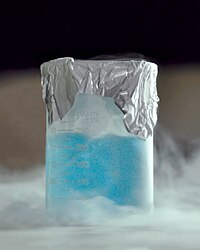
Photo from wikipedia
Liquid–liquid separation is crucial in the present circumstances. Substitution of the conventional types of separation like distillation and pervaporation is mandatory due to the high energy requirement of the two.… Click to show full abstract
Liquid–liquid separation is crucial in the present circumstances. Substitution of the conventional types of separation like distillation and pervaporation is mandatory due to the high energy requirement of the two. The separation of organic mixtures has a huge potential in industries such as pharmaceutical, fine chemicals, fuels, textile, papers, and fertilizers. Membrane-affiliated separations are one of the prime techniques for liquid–liquid separations. Organic solvent nanofiltration, solvent-resistant nanofiltration, and ultrafiltration are a few methods through which organic liquid–liquid separation can be attained. Implementation of such a technology in chemical industries reduces the time consumption and is cost efficient. Even though a lot of research has been done, attention is needed in the field of organic–liquid separation aided by membranes. In this review, various membranes used for organic mixture separations such as polar–nonpolar, polar–polar, and nonpolar–nonpolar are discussed with a focus on membrane materials, additives, separation theory, separation type, experimental setup, fouling mitigation, surface modification, and major challenges. The review also offers insights and probable solutions for existing problems and also discusses the scope of research to be undertaken in the future.
Journal Title: ACS Omega
Year Published: 2022
Link to full text (if available)
Share on Social Media: Sign Up to like & get
recommendations!